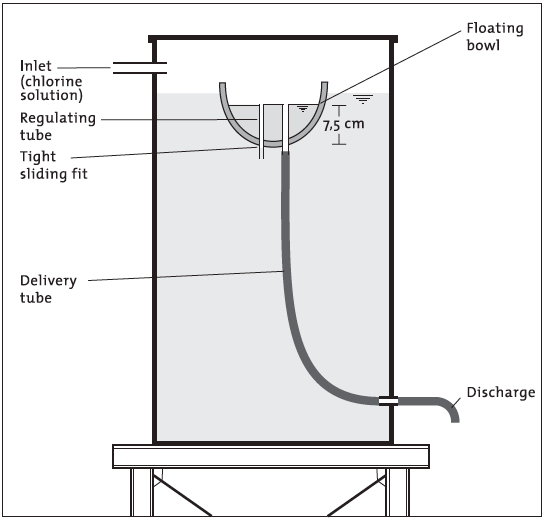Chlorination in piped systems
Chlorination is a chemical method for disinfecting water. The chlorine inactivates pathogens in the water and provides a barrier against recontamination. It is normally applied at the last stage of a drinking-water treatment process. The most frequently used low-cost technology methods are batch chlorination and flow chlorination. For batch chlorination, a concentrated chlorine solution is added to the water in a reservoir, with both inlets and outlets closed. The water is stirred and the chlorine is left to react for at least 30 minutes. After that, the outlets can be opened. When the reservoir is empty, the outlets are closed and the reservoir is refilled with a new batch of water to be disinfected.
Flow chlorinators continuously feed small quantities of a weak chlorine solution to a flow of fresh water, often at the inlet of a clear-water reservoir. Usually, a small reservoir containing the chlorine solution is placed on top of the water reservoir and the solution is administered close to the point where fresh water comes in, and turbulence guarantees good mixing. A special device, such as the floating bowl chlorinator, enables precise dosage. Sometimes a special electric pump is used for this purpose. Electrical devices that convert a solution of kitchen salt to active chlorine can be purchased for on-site chlorine production. Small test kits are also available for monitoring and for adjusting chlorine doses to the water quality and quantity. Chlorine-producing compounds must always be stored and prepared with care.
Yield: Generally, 350–1400 m3 of treated water per kg of a 70% chlorine compound.
Suitable conditions
Area of use: Wherever drinking-water needs to be disinfected and chlorine is available.
Construction, operations or maintenance
The flow rate of the raw water must be checked and adjusted if necessary, and the chlorine tank must be refilled with a freshly-prepared solution once or twice a week. Operators must be careful to avoid contact with chlorine compounds or solutions, and use protective gloves and utensils to prepare the chlorine solutions. The gloves and utensils will need to be replaced occasionally. In some cases, the amount of chlorine added to the water, together with residual chlorine levels, are recorded in a logbook. Chlorinators must be adjusted and cleaned of chlorine salts regularly, and when the hoses become corroded by chlorine they must be replaced.
If a steel chlorine tank is used, it must be painted and checked for corrosion every year, and the shelter for the chlorine tank needs to be maintained. Usually, the water committee appoints a caretaker who is trained for such work. The chlorine compound itself must be obtained from a merchant or the health department, and an adequate supply of chlorine compound must be kept in stock. An external organization, such as a government health or water department, will provide training for caretakers and perform monitoring.
Costs
Initial cost: A chlorinator and hoses can cost as little as US$ 15, but there will be additional costs for the tank, for the concentrated chlorine solution, and for the construction costs of a protective shelter.
Acknowledgements
- Brikke, François, and Bredero, Maarten. Linking technology choice with operation and maintenance in the context of community water supply and sanitation: A reference document for planners and project staff. World Health Organization and IRC Water and Sanitation Centre. Geneva, Switzerland 2003.

